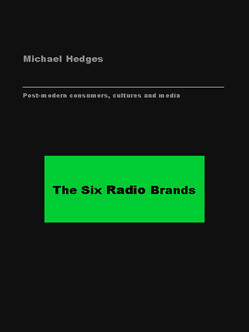ftm Radio Page - week ending April 26, 2019
Big channels in turmoil as local stations jump
classical music and all that jazz
Interesting twists and turns abound in audience behavior in many radio markets. Reasons are wide, varied and, often, quite unknown. In more than a few, audience levels are dropping due to aging formats, platform changes, boredom or bad weather. Sometimes good weather. Broadcasters struggle to keep up with it all.
French measurement institute Médiamétrie released the Ile-de-France - Greater Paris - radio audience estimates a week after the shocking report on national radio listening showing sharp changes among top national channels and deeply falling listening levels. (See more about recent French national audience estimates here) In Greater Paris, the results are much the same. Local stations, however, are continuing to show growth.
Public broadcaster Radio France’ main national general interest channel France Inter posted its highest audience share in more than two years - 14.3% - and placed first in Greater Paris for the January-March survey period. RTL dropped to second, 12.0% audience share from 13.7% year on year. News-talk channel RMC moved into 3rd place with 7.9% audience share, up from 7.6%. During the period the Gillet Jaune - Yellow Vest - protests were are their most violent, particularly in Paris.
Suffering national general interest channel Europe 1 suffered further, dropping to 5.8% audience from 7.9% one year on. Public all-news channel France Info retained 5th place but dropped to 5.5% audience share from 6.1%. Commercial classical music channel Radio Classique took 6th, 3.3% audience share, up from 2.7% and 9th place. National hit music channel NRJ and oldie music channel Nostalgie tied for 7th, rap/hiphop channel Skyrock following at 9th with public channel France Culture at 10th. (See France Ile-de-France radio audience share trend chart here)
Local stations eclipsed several second-tier national channels. Radio Latina and TSF Jazz both posted 2.6% audience share, up from 2.0% and 1.4%, respectively, one year on. Oui FM and Radio Nova were also up. National music channels Fun Radio, Rire & Chansons and RTL2 were significantly lower.
Broadcaster criticized for reporting speed traps
"accidents or lost animals"
Traffic reports have been part of radio programming for more than a generation. Automobiles are still the major venue for radio listening, typically during the morning commute to the workplace. Traffic reports - noting accidents, other distractions or simple density - are common. Savvy programmers worked out that literal information - breakdown on the A30 and such - is largely irrelevant as only a few people actually come upon the reported incident.
Traffic reports, not to forget those who present such, tell little stories with local context. Everybody likes hearing the name of a landmark they know. Plus, traffic reports have that public service appearance. And, of course, these are sponsorable.
Along came technology, as it always does, and highway driving conditions, always at peril for accidents, needed a bit more control for the sake of safety. People would, can you imagine, drive fast, sometimes exceeding speed limits. Those mandated to serve and protect citizens from the bad behavior of others - police and highway patrol - discovered radar to monitor speed. This irritated those attached to putting the pedal to the floor, so to speak.
Radio broadcasters adapted; announcing the locations of traffic radar installations, which typically move about as needed. In Switzerland, this distressed the highway patrol, not to forget local governments used to collecting stiff fines for speeding. A rule was established in 2013 forbidding radio broadcasters and online services from publicizing the locations of the active speed cameras.
Similar restrictions do not exist in France. Local French station Radio Plein Air has happily provided listeners with the locations of these speed traps, including in neighboring Switzerland. “This poses a real security problem because offenders can take other routes,” complained Grand Jura (Switzerland) council deputy Jacques-André Aubry, quoted by Swiss-French news portal 20min.ch (April 22). Radio Plein Air operates generally in the area of the Doubs Natural Park, which includes both countries.
“We are aware of this practice,” said a local police spokesperson. The reports “are primarily intended for cross-border drivers, who drive many kilometers to come to work and who may tend to drive too fast. These information flashes must not allow impunity for speeding in sections where there is no control.” An international incident is brewing, maybe.
“We carry local traffic reports every 15 minutes,” said station manager Sebastien Widmer, “with the constant concern for safety, traffic jams, snow, ice, accidents or lost animals. We can say that the share of them located in Switzerland is quite marginal. Finally, we encourage, whenever possible, to respect speed limits.”
Shock Fall In Listening Clips Big Channels
 Radio broadcasters work at the behest of the listening audience. This is immutable. Media buyers and especially the bots reward big audience and punish the rest. Shareholders approve bonuses for winners. The losers are asked to explain what happened. And they are only asked once.
Radio broadcasters work at the behest of the listening audience. This is immutable. Media buyers and especially the bots reward big audience and punish the rest. Shareholders approve bonuses for winners. The losers are asked to explain what happened. And they are only asked once.
Radio Page week ending April 19, 2019
radio in Denmark, Radio24syv, Berlingske Media, Jysk Fynske Media, radio in Italy, Radio Radicale, radio news, radio archives
Radio Page week ending April 12, 2019
radio in Norway, local radio, digital transition, NRK, media support, radio in Africa, local news, media development, community radio, UNESCO, Fondation Hirondelle, Media Development Investment Fund
Radio Page week ending April 12, 2019
radio in Norway, local radio, digital transition, NRK, media support, radio in Africa, local news, media development, community radio, UNESCO, Fondation Hirondelle, Media Development Investment Fund
Radio Page week ending April 5, 2019
radio in Russia, radio audience, audience measurement, Novy Radio
Radio Page week ending March 29, 2019
radio in Spain, Radio Marca, Cadena Cope, sports and media, radio in the Netherlands, radio audience, audience measurement, NLO, radio advertising
Radio Page week ending March 22, 2019
radio in Ireland, independent local radio, BAI
Radio Page week ending March 15, 2019
podcasts and podcasting, Spotify, Gimlet Media, Luminary, radio in Africa, radio in Nigeria, Jay FM, elections and media, radio in Russia, Ekho Moskvy, Gazprom Media
Radio Page week ending March 8, 2019
radio in France, CSA, DAB+, Air Zen, radio in Germany, consumer electronics, FM shut off, digital radio, radio in Switzerland, digital transition, music radio, Michael Jackson, NRK P1, BBC Radio 2, Spotify
Radio Page week ending March 1, 2019
radio in the UK, Global Radio, national radio brands, local media, Capital, Heart, Smooth, BBC Radio, media brands, DJs
Recently added radio audience figures and resources
- France - Greater Paris Radio Audience (April 2019)
national and local channels, market share, trend - France - National Radio Audience (April 2019)
national channels, sectors, market share, reach/TSL - Belgium - Flemish region, Radio Audience (February 2019)
market share, Sep-Dec 2017 to Sep-Dec 2018 trend - Belgium - French region, Radio Audience (February 2019)
market share, Sep-Dec 2017 to Sep-Dec 2018 trend - UK - National Radio Audience (February 2019)
market share, trend, sectors - UK - London Radio Audience (February 2019)
market share, trend - UK - National Radio Audience (February 2019)
BBC/commercial 'gap' - Poland - National Radio Audience (January 2019)
national survey, market share, trend - Spain - National Radio Audience (released November 2018)
national channels, reach share, trend - France - National Radio Summer Audience (September 2018)
national channels, summer period 2013-2018 trend - Netherlands - Radio Audience (May 2018)
national survey, market share, trend - Switzerland - Radio listening by region (Jaunary 2018)
public and private sectors, penetration, time spent listening - Switzerland - French region Radio Audience (January 2018)
share, trend - Switzerland - Swiss-German region Radio Audience (January 2018)
share, trend - Switzerland - Italian region Radio Audience (January 2018)
share, trend - Czech Republic - Radio Audience (November 2017)
Top stations, national survey, reach trend - Turkey - Major Media - Radio Broadcasting (October 2017)
ownership, management, program formats, platforms, audience estimates - Portugal - National Radio Audience (May 2017)
leading stations, audience share, trend - Germany - Radio Audience (March 2017)
leading stations, audience trend, daily reach - Romania - Radio Audience (January 2017)
national and Bucharest surveys, market share, trend - Italy - Major Media - Radio Broadcasting (July 2016)
public and private broadcasting companies, channels, audience reach/share, management - Spain - National Radio Audience (April 2016)
national channels, reach share, trend - Sweden - Major Media - Radio Broadcasting (February 2016)
public and private radio channels, owners, management, national market share trend - Poland - Major Media - Radio Broadcasting (January 2016)
public and private radio channels, owners, management, platforms, market share - Estonia - Major Media - Radio Broadcasting (December 2015)
public and private broadcasting companies, channels, management, platforms, audience estimates - Spain - Major Media - Radio Broadcasting (December 2015)
public and private broadcasting companies, channels, management, platforms, audience estimates - Ireland - Major Media - Radio Broadcasting (November 2015)
national public and commercial radio channels, major local/regional stations, management, listening share - Finland - Major Media - Radio Broadcasting (September 2015)
public and private radio channels, management, market share, platforms - Ireland - National Radio Audience (August 2015)
market share, 07h00-19h00, trend - Ireland - Dublin Radio Audience (August 2015)
market share, 07h00-19h00, trend - Greece - Major Media - Radio Broadcasting (June 2015))
public and private broadcasting, owners, executives, market share
More Resources
Also see ftm Knowledge
Europe's Radio - Southern Europe
Radio broadcasting in southern Europe ranges from highly developed to developing highly. Italian, Spanish and Portuguese radio is unique, creative and very popular. Radio in Croatia, Serbia and Greece has had ups and downs. The ftm Knowledge file includes Resources. 126 pages PDF (June 2015)
Order hereEurope's Radio - Western Europe
Opportunity meets tradition in Western Europe's radio broadcasting. Change has come fast and yet oh, so slowly. This ftm Knowledge file contains material and resources on public and private radio broadcasting in Austria, Belgium, France, Germany, Liechtenstein, Netherlands and Switzerland. 244 pages. Resources. PDF (September 2013)
Europe’s Radio – Eastern Europe
Eastern Europe’s radio writes new rules. In fact, most everything about radio in this region is new... and changes often. The ftm Knowledge file reports on Belarus, Bulgaria, Czech Republic, Hungary, Moldova, Poland, Romania, Russia, Slovakia and Ukraine. 159 pages PDF (April 2013)
Europe’s Radio – Northern Europe
Northern Europe’s radio has a very digital sound. And change is in the air. Economic challenges abound for both public and commercial broadcasters. The ftm Knowledge file reports on Denmark, Estonia, Finland, Iceland, Ireland, Latvia, Lithuania, Norway, Sweden and the UK. 144 pages PDF includes Resources (November 2012)
Digital Radio - Possibilities and Probabilities
Digital radio has many platforms. From broadcast platforms to internet radio and rapidly emerging smartphone platforms, listeners and broadcasters have choices galore and decisions to make. Some regulators have made up their minds, others not, some hedging their bets. This ftm Knowledge file details the possibilities for digital broadcasting and the probabilities for success. Includes Resources 149 pages PDF (August 2012)
Become an ftm Individual or Corporate Member and receive Knowledge files at no charge. JOIN HERE!
ftm Knowledge files are available to Members at no additional charge.

The Six Radio Brands is about the uniquely European development of radio brands. Competition among broadcasters - and certainly between the public and commercial sectors - gives radio in Europe a rich dynamic. As consumers become more media-literate and demand more attachment broadcasters find target markets illusive. 100 pages. 2004 Available at no charge to ftm Members, €49 for others. Email for more information |